What Turks suffered in Anatolia is well documented by international committees and even acknowledged by some Greek historians. Many Greek authors and commanders accept these atrocities as well.
Turks do not tend to weep over past much or worse, take lessons. They just accept to live with or forget about the pain because of their strong faith in the divine justice of afterlife.
In this answer, I will include Western Anatolia only, and not Southern and Eastern fronts.
So it’s still an untold story considering the constant hatred suffered by Turks despite their losses.
Ottomans had already lost its best armies with some 400.000 soldiers killed, 180.000 wounded and 200.000 being prisoners of war in the WWI.
Now it was time to pay another price for the participation of tyrant Young Turk leadership in the World War I: Sharing most of Anatolia among allies.
Allies were generous enough to leave some free space for Turks:
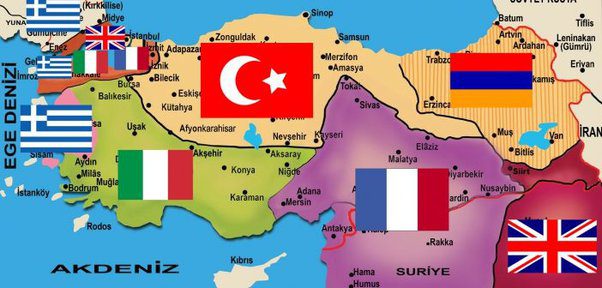
Greek leadership thought Anatolia was a rose garden without any thorns now, so Greek army invaded Izmir without any significant resistance in 1919, the main commercial port of Anatolia with big Greek population, thus starting the Turkish war of independence.
But Greek people were actually fed up with wars by 1920, they did not want any further military adventures in Anatolia beyond Izmir. So they voted for Dimitrios Gunaris who promised them that he would bring all troops back home.
But once elected, Gunaris and army commanders thought it would be foolish to leave the rest of Anatolia to Turks. So he did the opposite of what he had promised and tried to invade entire defenseless Anatolia to become the hero who would revive the Eastern Roman Empire once again. It looked like a low risk, big gain after all!
We should also not forget Churchil’s strong anti-Turkish feelings and commitment to drive them back to Central Asia. He is more responsible for this war than any Greek, because he provided extensive political and military support to Greece and encouraged them to attack Anatolia.
The Greek Army committed countless atrocities, massacres and systematic ethnic cleansing in Anatolia despite facing no standing armies (Most Ottoman Armies had been dispersed by Allies and most guns had been collected from cities). Only people who were spared were those who escaped to mountains without proper clothing and any food.
Some well documented war crimes committed by Greek Army:
Izmir province: When Izmir was occupied by Greek Army, a Turkish journalist shot at Greek soldiers. Enraged, Greek soldiers and collaborating Greek civilians in Izmir killed more than 2.000 civilians and soldiers who had peacefully surrendered in less than 48 hours of the occupation.
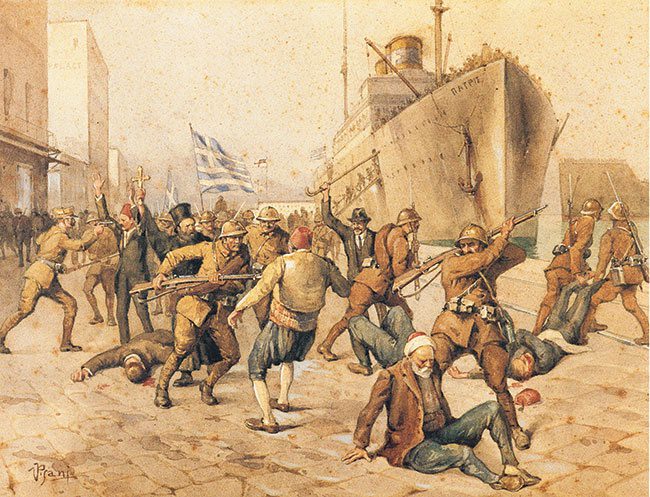
They also stopped a train from Izmir to Aydın which was carrying 97 muslim people. They shot 67 men among them and raped the remaining 30 women after taking them to Çirkince (now Şirince), a Greek village.
This was not made by random soldiers, but it was a part of a systematic order to cleanse the region from Turkish civilians, making Greek advance into Anatolian heartland easier.
In the town of Torbalı, 87 out of 200 houses were burnt and more than 50 people were killed and many girls were raped.
Aydın province: Then they proceeded to invade another town south, Aydın which also did not offer any resistance. Greek army separated the Turk and non-muslim civilians with some dress codes like hats and putting Greek inscriptions on Greek houses.
The destruction which Aydın and Manisa and some other towns suffered can be clearly seen in the video below.
AYDIN ,İZMİR 1922 Αϊδινίου, Yunan Ordusunun yaptığı yıkım görüntüleri
Then they started to occupy houses one by one and rape some young girls as young as 10 to 14. They burnt 11.500 Turkish houses and killed hundreds of men or women who tried to stop the rapes or tried to run away from the burning houses.
A burned mosque in town of Nazilli Aydın province is seen below. A Greek soldier poses.
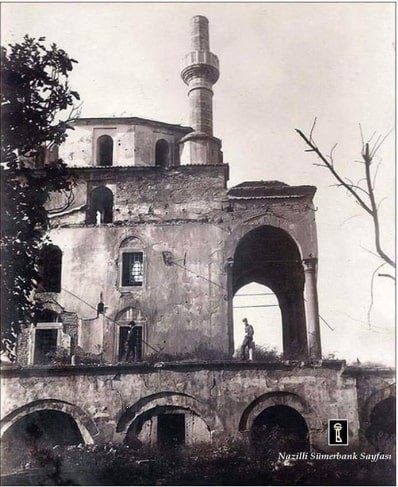
Aydın province suffered enormous destruction during the entire independence war. All the villages in the Aydın plain were demolished, looted and burned. While Greeks were fleeing before the advancing Turkish army at the end of the war, they tried to take revenge for their humiliation by killing another 205 people in Aydın, and around 300 people in Nazilli, destroying whatever left of entire towns in the province.
Greek soldiers also occupied nearby town of Germencik where they excuted more than 1800 civilian young men after calling them and recording their names.
All the men in Hızırbeyli village were put in the mosque of the village and were burnt alive. In Karapınar, Greek soldiers abducted 33 young women and girls from this town and they never returned. They also killed 28 people, burnt 200 houses, 2 mosques, 40 shops, 2 factories and 2 schools. In Gözpınar village alone, 245 people were killed. 89 villages around Aydın suffered similarly.
In Germencik, 63 young men were forced to gather in a house in which they were killed with bayonets and thrown in a well. Only one of them survived despite his 9 wounds and told the international committee what happened to them.
Many women and young girls from Aydın were raped and transferred to Athens for further rapes. A young girl in Nazilli who was going to fountain to fetch some water was captured by Greek soldiers who raped and killed her on the spot.
Manisa province: Atrocities in Manisa province were no less than those in Aydın. Around 3500 people were burnt in their houses and 855 people were shot dead. More than 300 girls were raped and many of them were carried away by soldiers. Majority of the girls never came back. All the livestock and grain stocks were plundered, so no food was left for civilian Turks there, leaving them to starvation even if they managed to survive the massacre.
Many people fled the city before and during the fire, but those who could not flee, like the elderly and children died burning in flames. Manisa was burnt down as seen below.
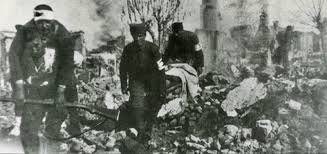
They killed 1200 people in Turgutlu, burning 5800 houses. In Alaşehir, another nearby town, there were 4000 houses before the occupation. After the liberation, only 100 of them were standing. 150 women and girls were raped and dragged away with the Greek army. Most of them were later killed. Around 600 people were killed in Alaşehir. Half of entire population was gradually massacred throughout the occupation. A woman named Emine who was running away from the fire was captured by Greek soldiers, her breasts were filled with gunpowder and burnt down. Atrocities in Alaşehir was extremely devastating and graphic.
In Menemen, around 1000 civilians in total were massacred. Hundreds of Turkish men were sent to Athens to forced labor and many perished because of lack of food there.
Manisa had been reduced to ashes and it was not more than a cemetery after the liberation in 1922 as seen below:
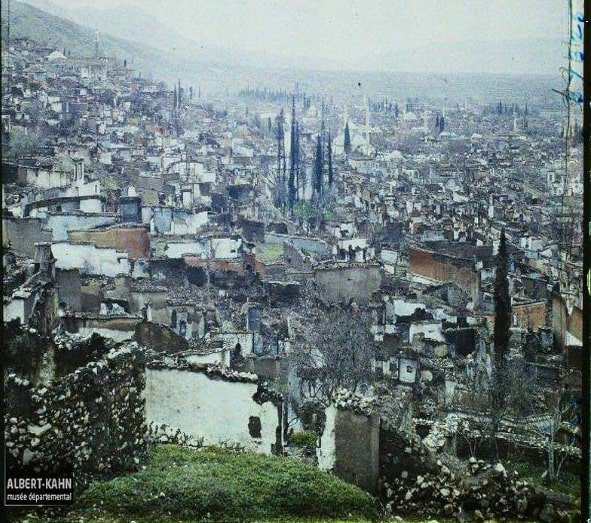
They burnt 18 villages in Tire, 60 in Ödemiş, 83 in Akhisar, Kırkağaç, Gördes and Soma. Thousands of people sought refuge in forests and mountains.
Entire town of Gördes was burnt down and out of 1500 houses, only 27 were left. 10 mosques were burnt down as well. More than 60 women and teenage girls were raped in Gördes and Kayacı alone.
Balıkesir province: Greek army and local Greeks killed 890 people in Bandırma alone, a seaside town of Balıkesir. 2228 were tortured, 1219 were wounded, 113 women and 94 virgin girls were raped. 6134 houses were burnt. All the money, food, livestocks were looted.
In this province there was a high concentration of Circassian immigrants who fled Russia 50 years earlier and welcomed by Ottomans who gave them land and accomodation, settling them throughout fertile regions of the Empire. But Circassians in Balıkesir declared that they were taking the side of Greeks and joined some atrocities against their fellow muslim Turkish brothers, the very people who had welcomed them and saved them from extermination in Russia.
Greek soldiers forcing Anatolian Turkish peasants -around 70 years old to dig their own graves.
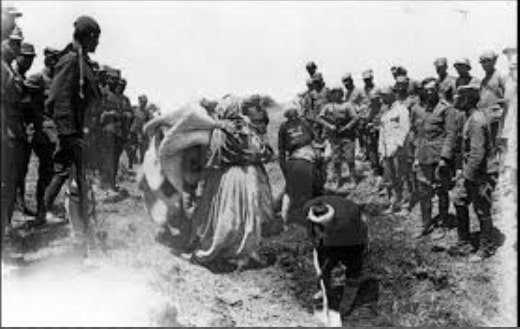
Bilecik province: This small province was the actual birthplace of Ottoman empire, as they first settled there. Greeks and Turks there had lived in harmony since the birth of the Empire. Greek soldiers had a special grudge against the town of Söğüt, the first Ottoman town ever, where Osman Ghazi I, founder of the empire was born.
In Bilecik, the provincial center, 1800 houses, 330 shops, 18 bazaars, 4 baths, 2 sufi tekkes, 1 masjid (small mosque) and 8 mosques, 2 silk factories, 9 bakeries, 6 government buildings, 2 schools were burnt. 22 people (women and men) were burnt alive, 8 strangled to death, 21 virgin girls were raped, 52 married women were raped, 18 fetuses were killed in their mothers wombs,
Bilecik after the liberation (photo taken by Frederic Gadmer, a French photographer):
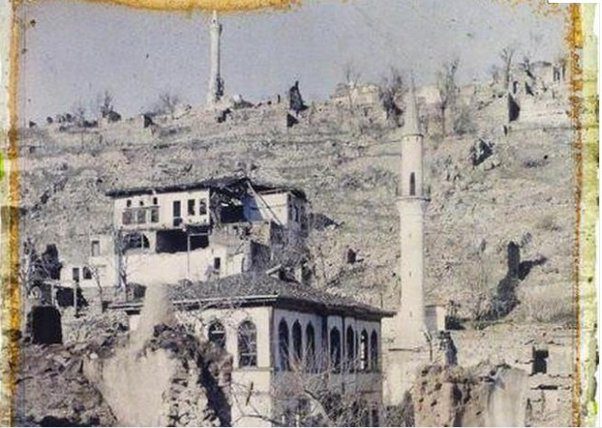
Almost all the villages and towns in the province were burnt down, hundreds of people were killed, hundreds of women were raped and carried away with the Greek army with no re-appearance.
In Söğüt, the birthplace of Ottomans, a 13 years old Turkish girl was raped and abducted by Greek soldiers. 40 men and 60 women were put in the Grand Mosque of the town and burnt alive with the mosque.
The tomb of Ertuğrul Bey, father of Osman Ghazi and founder of the Ottoman Dynasty was demolished, and his grave was dug by Greek soldiers as seen below. A muslim woman was raped and killed in the tomb with breasts cut off and body left there.
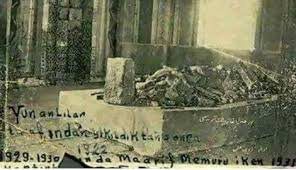
In the center of Söğüt, 350 houses were burnt. Many civilian muslims were killed and numerous virgin girls and young women were raped and dragged away with the Greek army. All of the properties, food and money were plundered.
In the villages around the town, aproximately 800 houses were looted and burnt. No villages were spared. Hundreds of people were tortured to death.
YUNAN İŞGALİNDEN SONRA BİLECİK’İN HİÇ GÖRÜNMEMİŞ FOTOĞRAFLARI
Christian Greeks who lived in Bilecik province (%30 of the province) in peace until that time (between 1071 and 1919, thanks to classic Seljuq and Ottoman tolerance) eagerly joined these atrocities and massacres against their own neighbors to get their own share.
Bozöyük town of Bilecik was extremely lucky to only suffer 7 rapes with only 7 houses burnt. But it was not due to forgiving nature of Greek army. All the people had fled the town and took refuge in mountains in advance.
Sakarya Province: This province was called Adapazarı then, now named after the Sakarya river. Greek occupation had reached the western bank of the river. Adapazarı was occupied on 26th of March, 1921 by Greek 11th Detachment.
Atrocities in this province form very long reports, but for short, local Greek and Armenian bandits and gangs started to attack villages after Greek occupation. 25 districts of the provincial center Adapazarı and 45 villages throughout the province were burnt down, and almost all villages suffered countless rapes. (The province population in 1914 was as follows: around 76.000 Turkish majority and some 8.000 Greeks and 16.000 Armenians)
Sapanca town also suffered heavily. 325 houses, 170 shops and storage rooms, 17 mills were burnt down, 55 people were taken captives and 24 people were killed. All nearby large villages were completely burnt down. While Greek army was withdrawing from the region, soldiers killed more than 100 men. All the villages suffered gang rapes, all the virgin girls and even young boys were raped. Greek army and Armenian gangs did all those horrible war crimes hand in hand.
Afyonkarahisar province: Greek army was fleeing before advancing regular Turkish forces this time, so they wanted to take revenge by putting 600 men in the Grand Mosque in Karahisar, the provincial center to burn them. This time, Turkish army arrived on time, so the men were rescued. Afyon and nearby towns suffered enormous destruction just like Uşak and Manisa.
386 people were killed in Karahisar, 17 in Emirdağ, 4 in Sandıklı, 65 in Sincanlı. 115 villages around Karahisar were occupied. 74 villages were completely burnt down.
221 girls and women were raped in Afyonkarahisar, 17 in Emirdağ, 6 in Sandıklı, 204 in Sincanlı. Even pregnant women were bayoneted in Eğret. There were countless accounts of massacre, arson, rape and looting throughout the province.
In village of Sipsin, 28 people were randomly killed. Sandıklı was briefly occupied, but it thoroughly suffered all kinds of massacres and rapes in those brief days.
In total, 472 people were killed in entire province, 132 people were taken prisoners, 448 women and girls were raped, 36.624 livestock animals and 1.176.600 kg food were looted and 2176 people were forced to labor. Still, this was a very lucky province. Greek army had no time to burn the city and commit atrocities, as it was retreating hastily.
An Anatolian Turkish woman is being forced by Greek soldiers to dance for them probably before being raped and killed, as seen below:
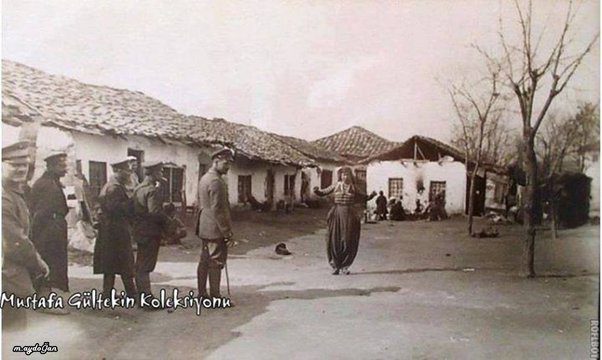
Uşak province: More than 300 muslim bodies were discovered near the city after the liberation of the city by Turkish national army. They were completely robbed off before being killed. 1785 houses, 634 shops, 16 mosques were burnt. 6 bodies of Muslim Turkish women were discovered in the city cemetery. There were stakes stabbed in their genitals. More than 1000 Turks had been killed in the province. Most atrocities were committed by local Greeks and Armenians who were allowed to live there in peace for 900 years after Turkish conquest of the region (A French report by M. Charles Giroud). Around 300 of the victims were children who had been gathered. They could not stand before soldiers and massacred innocent civilians instead.
UŞAK’TA YUNAN YANGINI VE MEZALİMİ
Kütahya province: Some Turkish men were forced to gather by Greek army, by commander Nekas, who had their beards and moustaches shaved, then made holes in their bodies, filling it with gun powder and burning them alive for fun. In Emet, they killed 28 women and men, destroying the entire town.
A raped Turkish woman.
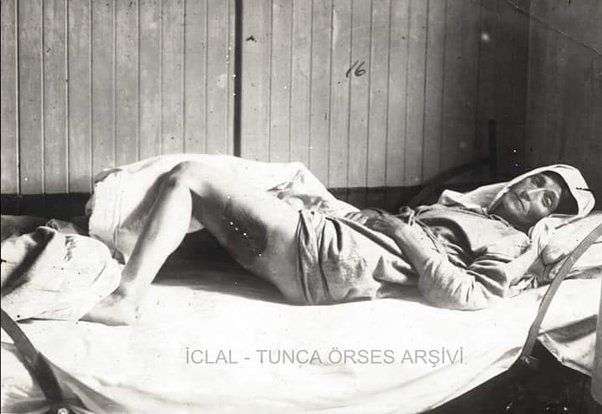
This mountainous province had been evacuated and it was not on the direct occupation line of Greek army, so it relatively suffered less than Aydın, Manisa or Bilecik. Another reason was the civilians who had now prepared themselves and they had standing defense units. Greek army was reluctant to deal with armed villagers. But whenever there was no resistance, they burnt houses, killed people, raped women without a second thought.
Yalova Province: Yalova suffered enormous destruction, as well. Villages were burned by local Greek and Armenian gangs in Yalova province, as seen below. They had become bolder with the presence of Greek army. Again, Circassians joined these massacres against their fellow muslim compatriots, as they felt no gratitude to their Ottoman saviors, following their own agenda.
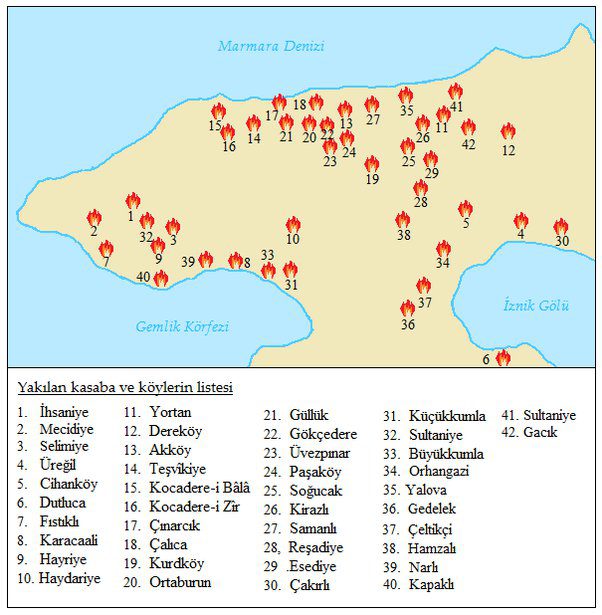
According to Maurice Gehri, the president of Red Cross committe that inspected the allegations of war crimes and massacres in Yalova region, 6000 Turkish muslims were killed in Yalova province. Ottoman figures include a larger area and 9100 people. 5500 people were killed in Yalova city center alone. Arnold Toynbee who was among the committee witnessed many of these atrocities and although he was a pro-Greek author until that time, he became an anti-Greek one after seeing so much massacre and destruction. In Kocadere alone, more than 500 people were massacred and burnt.
Denizli Province
This province was only partially occupied, namely towns of Çal, Buldan, Sarayköy and Çivril and their villages.
In Çal, they tortured some rich people to get their money, stole all the livestock and took it to Izmir, raped some women, killed random villagers who worked in their fields. Greek soldiers tortured a man from Molla village of Çal town who confessed the place of his 5000 liras, then killed him. They slaughtered most of the livestock in the village in Easter, beat some villagers who resisted them. Some women were raped in Şeyh Elvan and Kavaklar villages of Çal town and in the main square of the Şeyh Elvan village before eyes of the entire village.
In Buldan, some people were arrested for having guns. They were either buried alive or crucified. Soldiers crippled all the survivors. Village of Boğazçiftlik was burnt down together with its residents. 200 people were killed in Buldan town center alone. In Umurköy village, a Greek detachment gathered 24 civilians in a stable and burnt them alive.
In villages of Sarayköy, around 200 civilians were killed and some 30 women and girls were raped.
In Çivril, they killed around 10 people. In Cabar village, soldiers killed more than 90 including children, elderly and women, and then burnt down the village. A beautiful Turkish girl from Çivril was dragged to Athens to become forced mistress of a Greek commander.
As there was strong armed resistance in this province, fires in most towns were put down by national Turkish forces before fully affecting the towns and villages.
Bursa province:
Sofocles, son of Venizelos (Prime minister of Greece whom Greeks respect most and who started the war) kicks the grave of Osman Ghazi I, the father of Ottoman dynasty and founder of the empire in Bursa, one of the main cities of Turks after enjoying a booze with his soldiers in his tomb. He says: “Osman, I destroyed the empire you built”. After those “bold” words, he poses for a photo to save this moment.
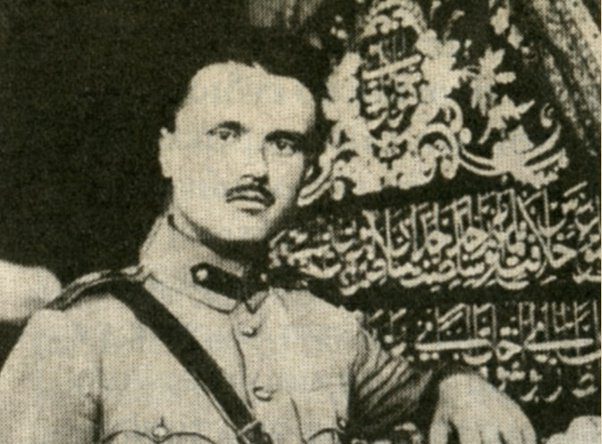
A mass burial site of Turks in Organgazi Town in rural Bursa.
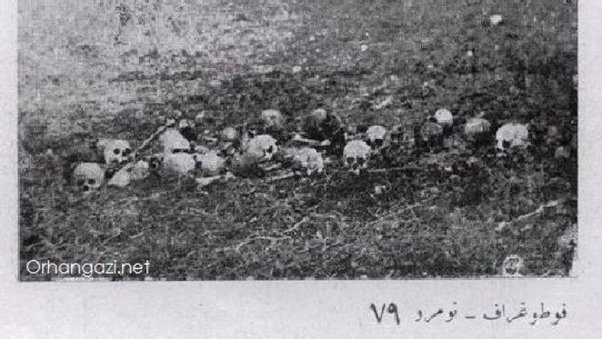
A burnt mosque in Yenişehir in Bursa province
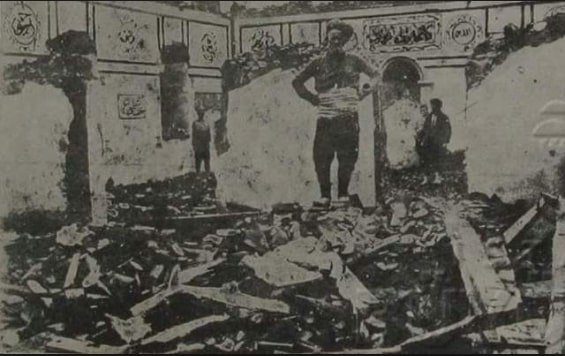
Greek soldiers had to evacuate the city as the Turkish army was coming closer. Before they left, they set fire to the prison where they held 657 Turks who were prominent people. All of them were burnt to death.
They would burn the entire city and commit the same atrocities, but this time Allies had foreseen this move, taken some measures and they did not leave the entire control of Bursa to Greeks.
Eskişehir province: Greek army burnt 45 villages entirely and 26 partially in Sivrihisar town only. They burnt people by gathering them in mosques. All the human settlements between Eskişehir and Sivrihisar had been reduced to ruins. Men who tried to protect their wives or sisters from rape were killed in villages of Mülk, Oğlakçı and Kocaş. Sivrihisar luckily suffered less casualties, as the Mayor who was a doctor himself was forced by Greeks to treat their wounded soldiers, and he required that no one would harm his town or people in return for his treatment.
Ankara province:
Greek soldiers taking some muslim women away with them in Haymana town of Ankara province, as seen below. Atrocities were less here, as the national Turkish army was here and fighting against Greeks. There was no time for easy war spoils.
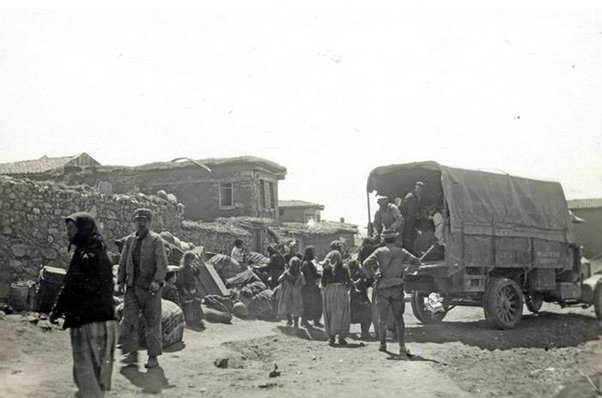
There are many untold statistics and stories as well. 97% of houses in entire Western Anatolia were destroyed. Hundreds of thousands of people were killed, tens of thousands of women were raped and thousands of them were abducted, millions of people were displaced. Tens of billion dollars worth of looting and vandalism were carried out.
Anatolia is at the crossroads of the Mankind and so it had always been an attractive fertile target and it had been invaded by many other nations countless times. Almost all nearby nations had invaded it whenever they felt that it was the right moment, from early Mesopotamian civilizations to Cymmerians, Hittites to Phrygians, Celts and Scythians to Medes, Achamaenid Persian Empire to Alexander the Great, Seleukos and Pontus kingdoms to the Roman Republic, Sassanid empire to Byzantine Empire, Muslim Caliphate to Crusaders, Seljuqs to Mongols, Ottomans to Timur, Safavids to Colonial Britain, France and Italy.
But it had never faced with such an extensive and complete destruction up to that moment. All the invading nations committed certain crimes and atrocities. But it was usually punitive actions to cities that refused to surrender or for looting. The conquerors usually admired local people and they were always ready to have more local people to get more taxes.
But this occupation was more devastating than all the others. Complete destruction of defenseless cities, towns and villages that were occupied without resistance is something beyond what human mind can conceive.
Cenghis Khan had spared some towns in Central Asia, even crusaders had skipped some cities in Levant, even Nazi Germany had spared some ethnicities like Poles and some cities in Eastern Europe. Seljuks and Ottomans had allowed Greeks to live in peace for 900 years. But in less than 3 years, Greek army destroyed entire Western Anatolia.
Special vandalism units in the Greece army destroyed entire towns and villages, and all the army committed all kinds of atrocities against defenseless civilians.
The region occupied and destroyed by Greeks is seen below. The smaller Izmir area was occupied by Venizelos and the rest by Gunaris governments respectively. The thick line shows the extent of Greek occupation. It took 3 years to occupy the region even when there were no real armies, but Turkish national army finally recovered its morale and strength and after an initial defeat in Eskişehir, and a tactic victory in Polatlı, it liberated the entire region in just one week after the Dumlupınar war in Kütahya.
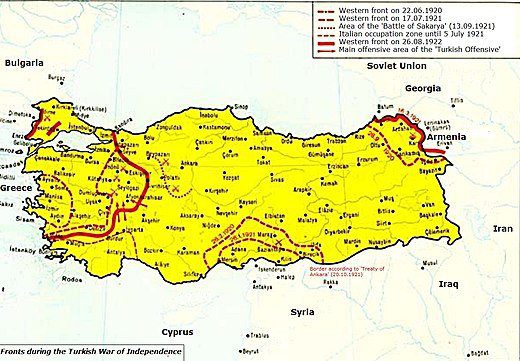
Note: I am not blaming people of Greece today, because no son can be considered guilty of his father’s crimes.
I am sure ordinary Greek people at that time didn’t mean any military intervention in Anatolia either, let alone atrocities. That’s why they voted for Gunaris who had promised them to withdraw troops, and later deceived them by taking the war much beyond Izmir. (In contrast German people had voted for Hitler.)
Some Greek commanders warned Gunaris that occupying Anatolia and killing Turks would be a catastrophe. They didn’t accept assignments made by Gunaris and refused to serve in Anatolia in the first place. Some of them wrote memories, and said that most Greek political and military leadership acknowledged the crimes committed by the Greek army and fully justified them by saying that “Turks would only understand this kind of language” and so they (the commanders who refused to accept positions in Anatolia) felt alone. There were always such silent honorable Greek people.
As a firm believer of Sufi values, I am sure many Greeks would share the same common values that I believe in.
Turk, Greek, Kurd, Arab, Russian or Serbian, woman or man doesn’t matter. There are only two kinds of people in this world. Good and bad. And good people are always overwhelmed by bad ones. Bad ones are everywhere and they are violent, evil, coward and wicked. They are the last in the battle front and the first in rape and plunder.
Just a small warning:
In Islam, it is believed that God will make everyone or everything pay for his big, small or tiny atrocities to a person, animal, plant or object with no exception.
Even leaves that fall off trees first and stay under the pressure of later falling leaves will be re-brought to the divine justice and they will be turned upside down this time to compensate for what they suffered. If God cares about even the pressure of later falling leaves, imagine how those atrocities will be punished in an eternal black hellfire which is thirsty of human flesh.

For those who feel bad for the victims: Every suffering of a muslim will be rewarded by God with so many generous rewards in the afterlife that they all will beg Him to allow them to go back to the Earth again and suffer a thousand times more this time. Because they will have gained rewards in just a few days, or an hour, normally what a decent muslim would have gained in a lifetime.


Leave a Reply